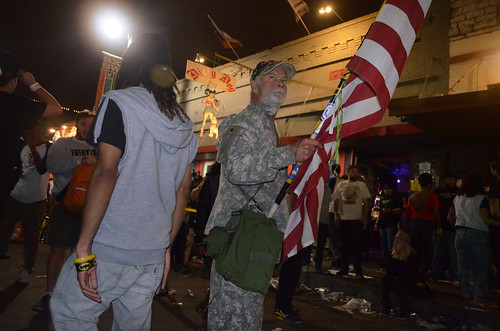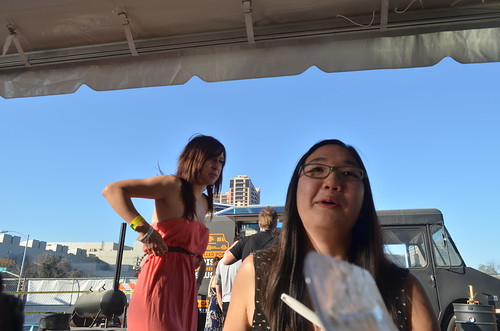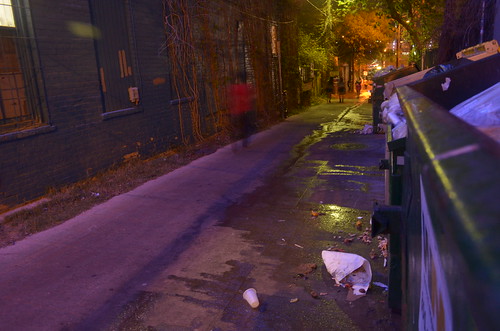Look Back In Squalor: East By Southeast
One week ago, my time in Austin, Texas covering the South By Southwest music festival came to a close. All the multimedia reporting done as Neon Tommy's uncredentialed eyes and ears can now be viewed as a standalone Tumblr page by clicking here.
Below is the final installment of the series East By Southeast.

It was perfect for our needs. A few pedestrians wandered by late at night, and only one morning were we awoken by a crying woman who said she needed a ride. Gomez told her there were a bunch of people hanging out at a record store down the road, and she might be able to get a ride from one of them.
She asked, with her voice cracking between sobs, “Want a date, daddy?”
“I...have a girlfriend,” Gomez said.
Really, temporarily dwelling in our vehicular transportation was painless. It suited the nature of the festival. One of my unofficial goals for the trip was to see if SXSW could really be done on the cheap and with minimal preparation.
It certainly can.
Neither of us paid for a single drink at a bar in Austin. Wi-Fi is free all over the city, though the government-sponsored bandwidth is slow to the point of allowing only the grittiest video uploads. Bringing our own bikes made getting around town fun. And regardless, Texas gas is cheap - under $3.25 per gallon. There were too many free shows at any given time to comprehend, leaving no cause for worry about missing official-wristband-purchaser-exclusive events.
We were denied attendance at only one show because I chose to opt out of buying credentials. It was the live-streamed Boiler Room DJ blowout sponsored by Ray-Ban, and I got turned away at the door after waiting in line for more than two hours. It was a brutal, never-before-experienced sensation. But spending that time queued up with a throng of happenstance acquaintances, sucking a pint of Wild Irish Rose and sipping Bud Light through straws in Styrofoam McDonald’s cups indubitably clued me into SXSW’s legitimate nature at least as much attending any concert.
My hope was that by attending the festival, I could learn about the nature of this liminal music performance period as an economic and social force. Short of that, the goal was to learn how this festival happens, and what it means for the town of Austin. The latter part of the question is probably better answered by the documentary Echotone, which deals with how this festival affects Austin's culture and creates complications.

During our last night in town, we met Tina Phan, a journalist I got to know through the Poynter Institute in 2010. She’s covered SXSW for the last three years as a reporter for the "Austin American Statesman." With her experience covering the festival, she astutely diverted my attention to people with even more experienced than herself when I asked her to describe what the festival is all about.
What she underscored was that, even as it’s become one of the utmost globally prestigious organizations of its kind, SXSW flies by the seat of its pants. A yard of congregated food trucks near the northeast bank of the Colorado River, Phan said, only got put together a week before the festival began. Her plan to spend the week of the music festival focusing on international artists fell through when the acts she planned on filming for in-depth features got bounced back at customs.
She also reiterated how important it is to think about the festival based on all its components, including the Interactive experience the week before the music side of the festival. When things end, she said the cleanup effort begins “that night.” After that, life goes on for Austinians pretty much as usual. After turning around her material in a quick, professional manner, Phan went back to photographing pug puppies for the "Statesman" the next day. People in her city appreciated the festival as a break from drudgery and, in a most significant way, an influx of outsider cash.
There are plenty of ways to slice into this event to understand its financial significance. Australian entrepreneur Georgia Hopkins said her SXSW efforts were richly rewarded. She set up shop in the form of a brand-new mobile espresso bar, serving coffee drinks and sweet crisps daily until 2 a.m.
"It was such an incredible experience," Hopkins said. "And I feel extremely lucky to have been given the opportunity to use SXSW as the platform by which to launch House of Card." Surpassing any immediate sales, she said the biggest payoff was the buzz generated by the venture. "The greatest reward for me was the amazing people I encountered, and the wonderful connections I made," Hopkins said.
In a post uploaded hours ago, Anthony Fantano attempted to dissect the importance of popular attention in generating phenomenal musical trajectories with the help of his YouTube audience. “It’s just one hype cycle after another, and it seems like right now in the music industry this is the most profitable model,” Fantano said. Musical names blowing up on one or two hits could mean artists with a propensity for success and great artistry are being acknowledged and supported with newly officious momentum.
The ascription of industry forces as being “too big to fail” has such a queasly laffable catchiness because it implicates that massive retooling or downright disintegration is the reasonable next step. The demand for forthright innovation is at least as high as ever, and, in this "American" tradition, requires people out of doors. That’s a reference to Austin and why this festival is more important than ever, why it keeps attracting more people, money and attention.
Vice is another crossover hit, perhaps the most signifigant organization of its kind at SXSW this year. What started as a government-sponsored mag out of Montreal pivoted to focus more on first-person glimpses into stuff like masturbating on crystal meth and has come to be a player in global politics.
Of course, this annual gathering in Austin works as a barometer and bellwether of the media group’s popularity. Vice’s efforts were part of bringing in people to the streets of Austin, and $200 million of those people's hard-earned cash will stay behind after everyone's packed up and left.
I also stood one afternoon like a sap for 25 minutes outside Viceland, the media conglomerate’s central pavilion. That followed failed attempts to squeeze in by means of secondhand wristbands, one found in the trashcan of a liquor store and another given to me from Lakutis, a rapper we encountered exiting the area on a pink mini skateboard.
On the south side of Viceland’s tent, some hundred people stood and sat, biding their time in the blazing Texan afternoon sunlight starting at noon to see a Kendrick Lamar show. SXSW activities are accessible to people free of charge is an extremely cool, extremely encouraging component of the experience. It led some people to act insane while demonstrating their ability to hold out for no-cost entertainment. When I made it through the venue’s barbed-wire palisade, I got a complementary drink containing Bullitt Bourbon, red wine and a frozen cherry as well as the chance to see “They Die By Dawn.” Karen Ahre occupied the seat next to mine and introduced herself as a friend of the director’s girlfriend. She flew in from St. Paul for the week, largely to attend the screening.
While exuding purely admirational enthusiasm for the filmmaker’s success in funding production and distribution, “The bourbon,” Ahre said, gesturing to one of Bullit’s dramatic illuminated installations, “has kind of overshadowed the movie.”
One of the artists quoted and featured in an audio clip above, Hot Sugar, suggested in a Tumblr post in February that success of any kind is a self-destructive illusion. He typified engagement with existence as “hideous, unfair and dictated by the worst aspects of human greed, selfishness & (sic) thirst.” These sentiments seem in line with the description of Cole Smith's broadcast on his Tumblr last Tuesday. Smith said the festival was composed of “drunk corporate goons and other industry vampires and cocaine,” stating that “here, the music comes last.”
Angela Brown, editor of Salt Lake City’s alternative magazine, "Salt," offered an entirely different reading of the festival’s significance. She gauged SXSW’s nature as a veteran attendee, having turned up in Austin annually for the last 11 years. When asked what stood out over all that time, Brown said, “How much it’s grown...The corporate sponsorship was nothing of a contentious issue in SXSW’s erstwhile days, and it needn't be now." Brown dumped fistfuls of rolling papers on a picnic table, each package emblazoned with the "Salt" sea-monster-green logo, her publication’s guerilla branding effort.
SXSW can suck for bands. Without substantial, premeditated support, attending requires nonviable up front expenses for most acts. Those that do earn a ticket run the risk of being industry grist. Remember RATKING, the band that last performed for a single-digit audience in Austin? Their label’s representative, Teplitsky, likened the fledgling band’s path to economic success to how “after Nirvana...everyone was trying to sign the next big grunge act.”
As no isolated tonal moment represents an entire melody, a discrete cultural junket cannot be used to accurately extrapolate the holistic import of modern music, even if the point of reference has been collectively designed to be such a telling face the way SXSW is.
But it was a damn good get-together. Stuff was cheap. A lot of people found work to do at the festival, and despite all the world’s long-term economic problems, plenty of them made money.
The biggest casualty that went down at the festival’s end, to my knowledge, hit inside the dashboard of Gomez’s Honda Odyssey. A chance to shower at the Statesman office had been mercifully extended around one in the morning, my first rinse in a week. Then, it was back on the road for us, careening across the stunning Texan steppe at no less than 80 miles per hour. To begin our return on a note of exuberance, the motivation struck me to begin the labor-intensive process of turning raw coffee beans into espresso. The materials were nestled beside me in the passenger seat. After plugging prerequisite apparatus into the minivan’s AC adapter, I flipped a switch on my circa-1970s bean roaster and promptly disabled the automobile’s auxiliary electrical system.
CD player, radio and nine-volt cigarette lighter adapted for charging cell phones. Kaput.
Gomez climbed toward the back of the car to sleep off a fit of churlishness induced by this snafu and the resulting lack of fresh espresso. Our plastic dome of a vehicle beat on, my dwindling perspicacity against darkness, merging with the ceaseless quiet of the night.
Epilogue
People have placed diminishing trust in their news sources for years, but hot fresh content is still worth eating up. And if that stuff gets stale, it’s less great. All new news is good, but old good news holds up exponentially better than old junk.
My maternal grandmother Trudy said the trip home always goes by faster than the time it takes to get somewhere. Any number of possible explanations exist as to why this perceptual phenomenon happens, assumably seeing recognizable landmarks provokes one’s brain into believing progress has been made in a way that doesn’t happen whilst one ventures into unknown territory.
Suggesting my subjective take on SXSW is due notice is no small feat of inflated self-importance. That everything to transpire in Austin a week ago was meticulously, expediently and thoroughly documented by other individuals, many of whom have more experience and higher salaries than myself.
And yet the tradition of first-hand reporting continues to yield unique results. For instance, I took this photo of an alley behind 7th Street. Tucked between popular venues, this cluster of dumpsters was immediately accessible to pedestrians but removed from the main flow of foot traffic.

All digital foreplay and integration duly noted, the nature of SXSW as a thing demanding physical action and bodily involvement persists. It is made by the people out of doors, to yank a phrase I first heard from Hannah Arendt. No doubt the same goes for the previous week’s Interactive gathering, as meeting in meatspace will be done away with as soon as conceivably possible.
In that sense, the dominant myth of South By is conclusively that defining your own trajectory can happen. It’s undeniable that no level playing field exists. Segregated spheres of privilege are as evident as the barbed wire surrounding Viceland’s spatial sector, same as the offensive razor wire running the span of the Mexico-U.S.A. border alongside the I-10. Remembering that such structures were created not by an eternal force, but mere, possibly well-intentioned folks is not something we have the opportunity to do all the time.
Shlomo, a Los Angeles-based DJ who played to ridiculously monstrous crowds in Austin, spoke off-the-cuff to a rooftop party on Thursday. He studded his panegyric on the delights of consumerist achievement. “I saw my first Ferrari yesterday,” he said. “It was a fucking thing of beauty.”
“We did it,” he repeated. “We definitely did it.”
Now what matters is what we do with it.
To contact Graham Clark, visit his website. Email him here, or follow him on Twitter here.



